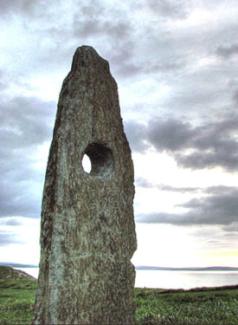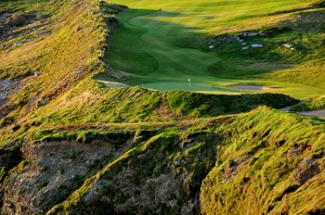Featured Golf News
Old Head Golf Links More than a Fabulous Location
Let me admit something before relating my experience at stunning Old Head Golf Links on Ireland's southern coast: Having the chance to play this course was the impetus for me traveling to the Emerald Isle and, for that, I owe Old Head and its marketing team a huge vote of thanks.

Heading onto the Old Head
Golf courses are usually dictated by one underlying tenet - they are what they are because of their locations. Would Pebble Beach, Torrey Pines or Bandon Dunes be so well regarded without their Pacific Coast settings; would Kiawah Island be the same were it removed from its lowland locale alongside the Atlantic; or would Liberty National Golf Club be as stunning removed from its expansive views of downtown Manhattan and the Statue of Liberty?
The same notion applies to Old Head, a great golf course made more spectacular by its stunning and singular place - a rocky, 220-acre promontory jutting more than two miles into the Celtic Sea and connected to the mainland by a narrow, tunnel-filled land bridge.
The course is exposed to the elements and, with dramatic 300-foot-high cliffs on all sides, provides ocean views from virtually every hole. The Old Head of Kinsale, as the peninsula is called and where the course was built in 1997, is a national monument and ancient royal site fortified by a castle with a history tracing back several centuries before the birth of Christ. This is a place with considerable archaeological and scientific interest.

Old Head's Stone of Accord
The Erainn Celtic people, the first Irish settlers, took over the peninsula and built the fort, the remains of which are still seen today, along with castles and a signal tower on Old Head. The "new" lighthouse was erected in 1853 to carry on an ancient tradition of fires used for navigational purposes to, from and around the promontory.
Another relic is the Stone of Accord, a circular stone with a small hole in the center; married couples and tradesmen would link their fingers through the aperture to renew treaties, marriage banns and business contracts.
Just off shore lie the skeletons of many wrecked ships, including the Lusitania, where 1,198 passengers and crew lost their lives to a torpedo from a German U-Boat in 1915, one of the pivotal moments of the 20th century. Today, just before you enter the secluded peninsula, a stone memorial reminds visitors of the tragedy.
Years prior to the development of the golf course, the site was used for little more than sheep- and cattle-grazing, and even then it was barely suitable for such a function as shepherds worried their sheep were falling over the cliffs.
Irish-American real-estate developers John and Patrick O'Connor, enchanted by this amazing chunk of land, aimed to produce one of the world's great golf courses on property that had more rocks than soil.

The 4th Green & Old Head's Lighthouse
Nonplussed, the O'Connors hired a unique architectural team: Ron Kirby (whose design resume includes stints with Robert Trent Jones, Jack Nicklaus and Gary Player); Paddy Merrigan (Australian course architect and agronomist); Liam Higgins (one of Ireland's best-known golf professionals); the late Eddie Hackett (former Irish golf professional and golf course designer); the late Dr. Joe Carr (Ireland's most successful international amateur golfer); and, finally, Haulie O'Shea (building contractor).
But before constructing the course, the site had to be cleaned up. Thousands of tons of rock were removed and thousands of truckloads of topsoil were imported as the tract was totally devoid of soil that could support consistent, durable golf turf.
No sooner would a hole be completed than punishing rains would wipe it out. But the O'Connors persevered and, eventually, a world-class course was established.

The 7th Green at Old Head
Keeping Focus Here is Tough
The Old Head experience actually starts before you even set foot on the course. The drive from Kinsale takes you through some rugged lands with no real views of the ocean or not much inkling of the area's rugged beauty. But as you approach the course you come over a hill and take your first glimpse of this diamond-shaped peninsula, a sight that takes your breath away.
On to the course: Par-72 Old Head GL stretches 7,159 yards from its back set of five tees. The designers used virtually every available square inch of space to produce a fine routing that continually piques your interest.
There are no gimmicks, just straightforward golf holes that present a variety of shot-making options amid ever-changing sea breezes. Nine holes play alongside the tops of the cliffs, providing an exhilarating test of golf and involving concentration for players of all categories.
Old Head consists of five par-5s, five par-3s and eight par-4s and is designed as a walking course. The green complexes at each hole are as open as possible, thus offering a view of the ocean from every hole and every angle. In a sense, the player feels alone in a world set upon a stunning perch high above the ocean. The course is really an isolated golfing fortress, engirded by waves smashing against cliffs on all sides.
After getting your swing in order on the 446-yard par-4 opener (set inland), No. 2, a 402-yard two-shotter, is the first hole to skirt the cliffs, swooping downhill and leftward to a putting surface that clings dangerously to a tiny piece of the Old Head.

The 11th Hole at Old Head
Nos. 3 and 4 continue along this border where ocean meets rock. The 178-yard third is a dazzling par-3 with a tee box so close to the edge that those with acrophobia might get squeamish; the green sits even closer to the precipice. No. 4 is considered one of the top four-4s in the world. With the lighthouse in the distance, the sea has you trapped on the left for as far as you can see. The daring approach must be hit up a hill and squeezed between a rocky shelf to the right and a hundred underwater shipwrecks toward the left.
After playing the par-5 sixth, you'll pass through some ancient ruins and find the striking 192-yard, par-3 seventh. There's no margin for error here as a steep slope to the right has signs warning you of the dangers lurking below.
No. 9 may be the toughest two-shotter at Old Head, as the 465-yard, slight dogleg-left moves uphill to a well-bunkered green. The 207-yard, par-3 11th has the ocean to the right and mounds of fescue on the left. When playing into an always-stout wind - which is always blowing here and comes from every direction, this hole is real tester. Landing in either of the two shallow bunkers just short of and to the right of the green isn't bad because they keep your ball from ending up in the ocean 250 feet below.
The 12th and 13th holes traverse the tunneled land bridge between the mainland and peninsula. No. 12, played from an isolated tee some 50 feet below the fairway and hanging on the edge of a cliff, is a 564-yard par-5 with the ocean along the left. Anything hit short or left will rattle off the cliff and die in a watery grave in the foaming, churning sea below. From the fairway's landing area, the play is downhill to a tiny green in a bowl with cliffs and the ocean on one side and fescue mounds elsewhere.

Old Head GL from Above
The 13th is a 258-yard (!) par-3 that takes you back out to the peninsula, and if the wind was at your back on No. 12, you're hitting dead into it this hole. With the wind in your face, a well-hit driver and a favorable bounce might get you in a position to make par, but good luck.
The 15th, 16th and 17th each have the ocean along their right. No. 15 is a downhill, 342-yard par-4 where the prudent play off the tee is critical, even though big hitters may drive the green with 4-iron with a backing wind.
No. 16 is a tricky, 186-yard par-3 with a putting surface in another bowl; the green is partially hidden by a wall built directly on the cliff. At 623 yards, the 17th runs along the high coast, heading fairly straight downhill. At about 100 yards before the green, the fairway bends rightward to an elevated green that's at least 100 feet below the tee and protected by sand, mounds, cliffs and ever-present ocean.
The back tee on the 434-yard 18th at Old Head is perched precariously under the lighthouse. The drive here requires a carry of about 230 yards in order to reach the landing area.
Though many may consider Old Head a links course because of its proximity to the ocean, it belies that category of course. It's not built on sand, there isn't large sand dunes on the property, nor is the sea within touching distance. That's not to say that some holes don't have a links feel.
Like a links, however, its challenge is enhanced by the constantly shifting winds that buffet all airborne shots. The course is so exposed to the brutal breezes that it must be closed in winter because it's unplayable. Selecting the correct club is also difficult because of the lack of an orienting background.
Playing a round of golf at Old Head makes you feel as though you're on the edge of the world. There are seagulls flying below you, and waves reverberate in the many caves hollowed out of the headland's base, making a tremendous booming noise.
Yes, the location is awesome, but Old Head is more than just its otherworldly setting. A round here is an experience that should be on any golfer's bucket list, and playing well on such a challenging track is perhaps the greatest satisfaction of all.
For more info, see http://oldhead.com.
Steve Habel is one of Cybergolf's world correspondents, contributing news stories, features, equipment and book reviews and personality profiles from his base in Central Texas. He is also works as a contributing editor for Horns Illustrated magazine, a publication focusing on University of Texas sports, covers the Longhorns for CBS Sports, is regional editor for Texas Golfer magazine and files stories for Golf Oklahoma magazine, Texas Links magazines and Golfers Guide. Habel's main blog (www.shotoverthegreen.blogspot.com) features news on golf and the Longhorns, and another (www.checkinginandplayingthrough.blogspot.com)chronicles his many travels, on which he has played more than 350 golf courses since 2009. Habel is a member of the Golf Writers Association of America and the Texas Golf Writers Association.
Story Options
 |
Print this Story |
